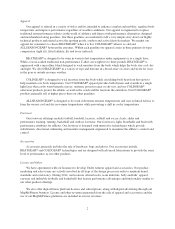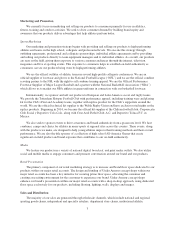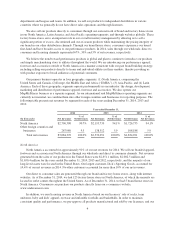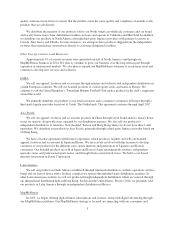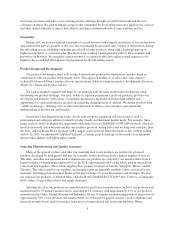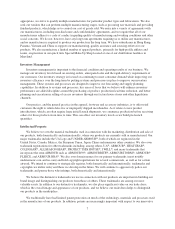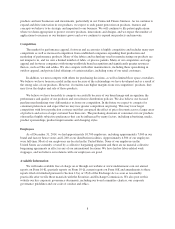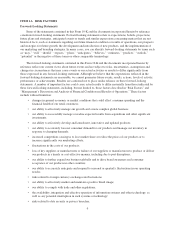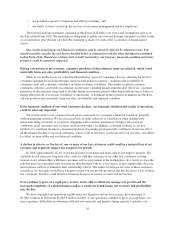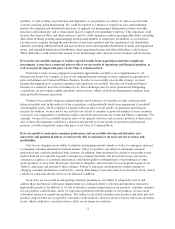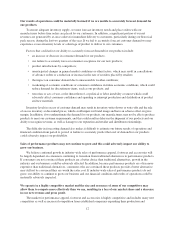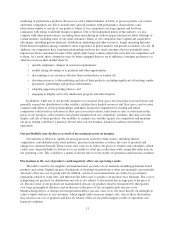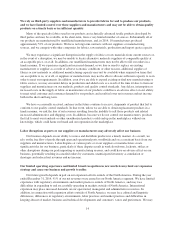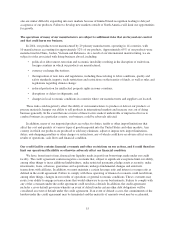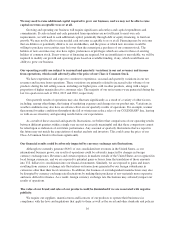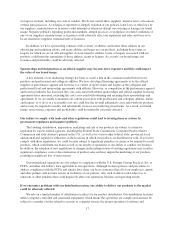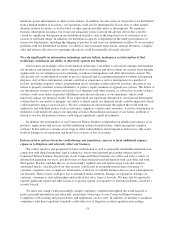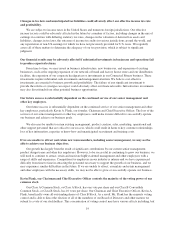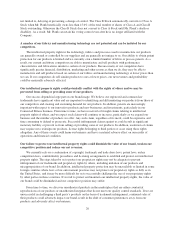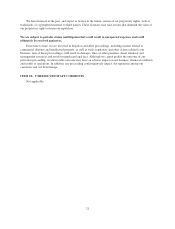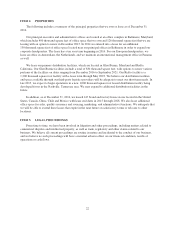Under Armour 2014 Annual Report Download - page 22
Download and view the complete annual report
Please find page 22 of the 2014 Under Armour annual report below. You can navigate through the pages in the report by either clicking on the pages listed below, or by using the keyword search tool below to find specific information within the annual report.O
ur results o
f
o
p
erat
i
ons could be mater
i
all
y
harmed
if
we are unable to accuratel
yf
orecast demand
f
o
r
our
p
ro
d
ucts.
To ensure adequate inventor
y
suppl
y
, we must forecast inventor
y
needs and place orders with our
manufacturers before firm orders are placed b
y
our customers. In addition, a si
g
nificant portion of our net
r
evenues are
g
enerated b
y
at-once orders for immediate deliver
y
to customers, particularl
y
durin
g
our historical
p
eak season, durin
g
the last two quarters of the
y
ear. If we fail to accuratel
y
forecast customer demand we ma
y
experience excess inventor
y
levels or a shorta
g
e of product to deliver to our customers.
F
actors that could affect our ability to accurately forecast demand for our products include
:
•
an increase or decrease in consumer demand for our
p
roducts;
•
our
f
a
il
ure to accurate
ly f
orecast consumer acceptance
f
or our new pro
d
ucts;
•
product introductions by competitors
;
•
unanticipated chan
g
es in
g
eneral market conditions or other factors, which ma
y
result in cancellations
o
f advance orders or a reduction or increase in the rate of reorders placed b
y
retailers;
•
t
h
e
i
mpact on consumer
d
eman
dd
ue to unseasona
bl
e weat
h
er con
di
t
i
ons
;
•
weakening of economic conditions or consumer confidence in future economic conditions, which could
r
educe demand for discretionary items, such as our products; an
d
•
terrorism or acts of war, or the threat thereof, or political or labor instabilit
y
or unrest which could
a
dversel
y
affect consumer confidence and spendin
g
or interrupt production and distribution of product
a
nd ra
w
materials.
I
nventory levels in excess of customer demand may result in inventory write-downs or write-offs and the sale
o
f excess inventory at discounted prices, which could impair our brand image and have an adverse effect on gros
s
margin. In addition, if we underestimate the demand for our products, our manufacturers may not be able to produc
e
p
roducts to meet our customer requirements, and this could result in delays in the shipment of our products and ou
r
ability to recognize revenue, as well as damage to our reputation and retailer and distributor relationships
.
T
h
e
diffi
cu
l
t
yi
n
f
orecast
i
n
gd
eman
d
a
l
so ma
k
es
i
t
diffi
cu
l
t to est
i
mate our
f
uture resu
l
ts o
f
operat
i
ons an
d
fi
nanc
i
a
l
con
di
t
i
on
f
rom per
i
o
d
to per
i
o
d
.A
f
a
il
ure to accurate
ly
pre
di
ct t
h
e
l
eve
l
o
fd
eman
df
or our pro
d
ucts
cou
ld
a
d
verse
ly i
mpact our pro
fi
ta
bili
t
y
.
S
ales of performance products may not continue to
g
row and this could adversely impact our ability to
g
row our business
.
We believe continued growth in industry-wide sales of performance apparel, footwear and accessories wil
l
be largely dependent on consumers continuing to transition from traditional alternatives to performance products
.
If consumers are not convinced these products are a better choice than traditional alternatives, growth in th
e
industry and our business could be adversely affected. In addition, because performance products are often more
ex
p
ensive than traditional alternatives, consumers who are convinced these
p
roducts
p
rovide a better alternative
may still not be convinced they are worth the extra cost. If industry-wide sales of performance products do not
grow, our ability to continue to grow our business and our financial condition and results of operations could be
materially adversely impacted
.
We operate
i
nah
i
ghly compet
i
t
i
ve market and the s
i
ze and resources o
f
some o
f
our compet
i
tors ma
y
allow them to compete more e
ff
ect
i
vely than we can, result
i
ng
i
n a loss o
f
our market share and a decreas
e
i
n our net revenues and gross pro
fi
t
.
The market for performance apparel, footwear and accessories is hi
g
hl
y
competitive and includes man
y
ne
w
competitors as well as increased competition from established companies expandin
g
their production an
d
12


